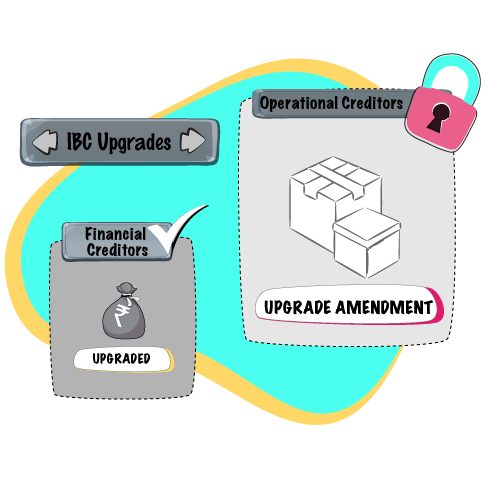Resolution Plans = Right To K(No)w?!

The IBC rigmarole
The Insolvency and Bankruptcy Code, 2016 (“Code”) was enacted to address, increasing, inter-alia, cases of corporate defaults in a regulated, time bound manner. It was also intended to streamline liquidation of NPAs, expedite debt recovery and insolvency resolution mechanism. Since its enactment in 2016, the Act has undergone periodic amendments. Such amendments addressed issues such as interpretation of the provisions of the code, applicability of the code to various stakeholders, procedural clogs in the course of resolution procedure were some of the issues that Tribunals and Apex Court were encountering.
The amendment
Of a host of periodic amendments introduced by the government, a key amendment was introduced in and became effective in 2019. The Amendment Act, 2019 (26 of 2019) seeks to make the resolution plan binding on all parties including the Central and State Governments or any local authority who have claim(s) against the corporate debtor.
Documentation in insolvency resolution process
The Insolvency and Bankruptcy Code, 2016 read with the IBBI (Insolvency Resolution Process for Corporate Persons) Regulations, 2016 contain express provisions of details and process / procedure in preparing and drafting such documents, primary amongst them being-
- Information Memorandum
- Invitation for expression of interest
- Evaluation Matrix,
- Request for resolution plan and
- Submission & approval of Resolution Plan(s).
These documents are crucial in enabling decisions to be taken by various stakeholders. It therefore becomes imperative to ensure these documents are fool proof and authentic. It is essential to ensure that the content and presentation of these documents are of the highest order accuracy, relevance in detailing and presentation. An insight into key content of each of these documents is as under:
(A) Information Memorandum
The information memorandum contains specific information of the corporate debtor including but not limited to the details as prescribed under sub-regulation 2 of Regulation 36 of the Insolvency and Bankruptcy Board of India (Resolution process for Corporate Persons) Regulations, 2016 (“CIRP Regulations”). It is collated and compiled by the Resolution professional.
It contains basic statutory and business information relating to the corporate debtor – (i) overview of the company, (ii) Profile of the Corporate debtor (iii) capital structure and share holding pattern, composition of the board, main business objects, Assets & liabilities, financial statements, current and projected business plan & strategy, key industry trends and growth factors, List of employees, List of operational and financial creditors, litigation details and related information.
The information memorandum throws light on details which can be obtained from the public domain – Government and company website; statutory (tax / RoC) authorities and documents such as memorandum & articles of association. The information memorandum provides basic information to enable a potential investor or stakeholder on whether they wish to further investigate into the company. The information memorandum contains information which the recipient considers material.
(B) Invitation of expression of interest
Interest must be formally expressed in writing by prospective applicant(s). This is called “expression of interest” (EOI) in the IBC process.
The Resolution applicant (RP) must publish an invitation for expression of interest in the prescribed Form not later than 75 days from the commencement of insolvency proceedings. Else it will be rejected. The EOI shall be accompanied with certain undertakings such as the resolution applicant’s eligibility to submit an EOI, relevant documents and records to substantiate the eligibility, an undertaking for authenticity of documents submitted and for maintaining confidentiality during the CIRP process.
On receipt of EOI’s from various prospective applicants, the resolution professional (RP) shall conduct a due diligence based on the documents and information submitted in the EOI by each prospective resolution applicant. the RP may, at his / her discretion seek additional information / documentation. Within 10 days from the last date of EOI submission the RP shall put out a list of provisionally eligible prospective applicants. The final list of selected applicants shall be published 5 days after the 10 days when the provisional list was published.
Provided that where the application is made under clause (b) after the issue of invitation for expression of interest under regulation 36A, the applicant shall state the reasons justifying withdrawal after issue of such invitation.
(C) Evaluation Matrix
Evaluation matrix is a document that contains list of parameters, method(s) and means of applying such parameters for considering and approval of resolution plans.The evaluation of a resolution plan will be based on a 70:30 ratio of quantitative and qualitative parameters It is wholly prepared by the Committee of Creditors (CoC)
Quantitative parameters: Net present value (NPV) of payments made to financial creditors, to creditors other than financial creditors, infusion of equity to improve business operations and related details.
Qualitative parameters: Reasonableness of financial projections, ability to honour commitments, Managerial and employee competence, technical capabilities of turning around stressed companies, experience, track record of the resolution applicant, external credit rating of the corporate debtor and financial discipline.
The quantitative and qualitative parameters should ensure just and equitable treatment to all the interested stakeholders.
(D) Request for Resolution Plan
The RFRP means a document that lays down the process for submission of Resolution Plan and selection of Successful Resolution Applicant(s) including all supplements, annexures and amendments thereto. The RFRP should be prepared and issued by the Resolution Professional of the Corporate Debtor in consultation with and approval of the Committee of Creditors (CoC).
The RFRP is issued for general information purposes, without regard to specific objectives, suitability, financial situations and the requirements of any person or resolution applicant. It does not constitute a recommendation of an offer to buy, purchase or subscribe to any securities mentioned therein. Resolution applicant(s) should have signed the confidentiality undertaking to be eligible to receive the RFRP. Besides general information (like in the Information memorandum) the RFRP should lay out the resolution plan per se, process of examination the resolution plan submitted by various applicants. It must be checked to see whether such plan is in accordance with the IBC and CIRP regulations. The Committee of Creditors (CoC) will satisfy itself as to the adequacy and viability of a plan and then finalize on the same. It has the right to negotiate or modify such parts of the plan with the resolution applicant to ensure that the plan is maximum beneficial to both parties.
(E) Submission & approval of Resolution Plan(s)
A resolution plan is a proposal that aims to address and resolve the insolvency problem of a corporate debtor (especially its inability to pay off its debts). The plan should endeavour to keep the corporate debtor as a going concern. The objective is not only to liquidate the corporate debtor but to ensure it remains a going concern after the completion of the insolvency process.
An effective resolution plan should contain not only the details of the background of the resolution applicant but also such applicant’ experience in the said industry, its management structure, the resolution plan, an objective summary of the rationale behind its proposed resolution plan, the timeline and payment structure of the financial and other creditors in accordance with IBC and CIRP regulations, competitive edge it has over other applicants amongst other details.
Whilst rolling out the most effective resolution plan, the resolution professional (RP) or interim resolution professional may seek the assistance / direction of the local administration in discharging their duties as an RP.
Besides the resolution conforming to the criteria specified in section 30 (2), the plan must provide for payments of insolvency process costs including fee paid to authorized representatives, fixed expenses, expenses approved /ratified by the COC, in priority to other debt, repayment of operational creditors, compliance with applicable laws and meet other conditions that may be specified by IBBI. The Adjudicating Authority on satisfying that the resolution plan approved by the COC meets the requirements of section 30(2) shall approve the resolution plan which shall be binding on the corporate debtor and its employees, members, creditors, guarantors and other stakeholders involved in the resolution plan.
Lifting the veil
Keeping in view the law and the fine balance of interests between stakeholders, it is only logical that the documents such as information memorandum, evaluation matrix, request for resolution plan and the resolution plan be made available to stake holders whose interests are affected to ensure that each or a group of their interests have been taken into account and addressed satisfactorily. However, in order to ensure that such resolution plans are not misused and put out in the public domain before the approval of the adjudicating authority, there must be a provision for stake holders to enter confidentiality agreements / undertaking. It may be borne in view that the resolution plans even after approval by the Competent Authority are not within the public domain in-spite of no such prohibition in the Code. Among others, operational creditors are kept in dark about resolution plans and they are constrained to accept what is given to them. It may be borne in view that there cannot be any commercial secrets on approval of the resolution plan by the Adjudicating Authority
Drafting and preparation of IRP documents, requires considerable skill, experience, expertise and due diligence. By allowing stakeholders access to documents in the stage before finalization and approval, will not only ensure they are included satisfactorily, but will be a step forward in the drafting, finalizing and approving a fool proof resolution plan that ensures maximum satisfaction of stakeholder interest. The next amendment in the offing?

